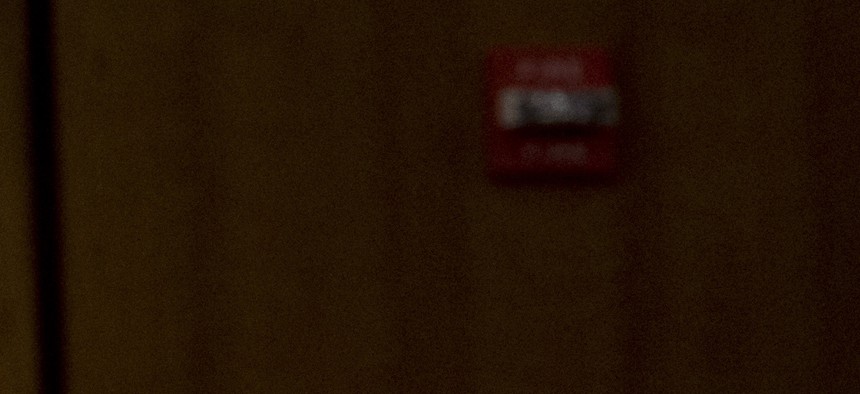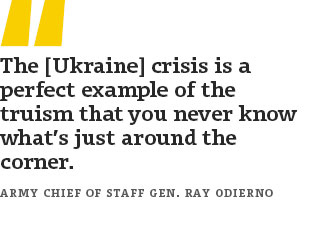
Army Chief of Staff Gen. Ray Odierno attends a hearing on Capitol Hill last June. J. Scott Applewhite/AP
Odierno: Ukraine Shows Us ‘You Never Know What’s Around the Corner’
In an exclusive interview with Defense One, Army Chief of Staff Gen. Ray Odierno talks about the future of the Army and the threats posed by an unstable world. By James Kitfield
In the waning days of the Vietnam War, with anti-war fervor and the Watergate scandal roiling the nation’s capital, legendary commander and soon-to-be Army Chief of Staff Gen. Creighton Abrams lamented to his colleagues that they would never know what it was like trying to bring the Army home from an unpopular war while the government back in Washington was coming apart at the seams.
As it turns out, Gen. Ray Odierno knows just what Abrams was talking about. As the current Army chief and former commander of U.S. forces in Iraq, Odierno has attempted to bring the Army home from an unpopular war in Afghanistan, and to downsize it, even as political paralysis has gripped Washington and military leaders argue cuts imposed by sequestration have created a readiness crisis. The result has produced the most dire warnings about military preparedness from the Joint Chiefs of Staff since former Army chief Gen. Edward “Shy” Meyer publicly declared in 1979 that the nation had a “hollow Army.”
Defense One contributor James Kitfield spoke with Odierno about the health of the Army, lessons learned from a decade of war and the threats posed by an unstable world. Here are edited excerpts from the interview:
Defense One : You have said that sequester cuts have led to “the lowest readiness I’ve seen in our Army since I’ve been serving for the last 37 years.” Are we headed back to the “hollow Army” of the post-Vietnam 1970s?
Odierno: Well, we’re not hollow yet, but I would definitely say that the instrument of sequestration is causing un-readiness. Because of the immediate, significant cuts in our planned budgets, sequestration has upset this pyramid of ‘readiness,’ ‘end strength’ and [equipment] ‘modernization’ that forms the U.S. Army. To be successful we need to keep that pyramid in balance, which is impossible when we have to absorb major funding cuts so quickly. Even under current plans we have to reduce our end-strength of soldiers in order to invest in readiness and modernization. That takes time, so we have about a 3- to 5-year window where readiness is going to suffer, and to a degree our modernization will also suffer, as we get down to a reduced end strength. And all of that is going on at a time when we’re not at peace. I still have tens of thousands of soldiers deployed today.
Defense One : What does it mean when you say military readiness “will suffer?”
Odierno: Well, I’m already prioritizing readiness such that a certain portion of U.S. Army forces are really ready, and other portions are not ready. So we have ‘tiered readiness.’ And we’ll probably have to continue with [tiered readiness] through about fiscal 2019. I worry that during that 3-to-5 year window, we are going to be vulnerable. The thought that keeps me awake at night is that something unanticipated happens and I’m told we need to deploy 20,000 soldiers and they are not ready.
Defense One : The Pentagon’s recently released budget proposal calls for shrinking the Army to its smallest size since before World War II, with end strength dropping from a post-9/11 peak of 570,000 to between 440,000 and 450,000 soldiers. Yet if sequestration caps kick in again in 2016 as mandated under current law, won’t you need to reduce end strength even more?
Odierno: Yes. What is happening is that soldiers cost double today what they cost in 2001. If we continue to lose money, we will have to get smaller and smaller than we are now. We are supposed to go to 420,000. We might have to go to 250,000. Then we are becoming an Army that no longer is capable of doing the things the nation needs its Army to do. So when we start to bring readiness back into balance around fiscal 2019, I’m concerned the Army is going to be too small to meet all of our responsibilities. We’ll be back in balance in terms of readiness and modernization, but will we be big enough to do what’s asked of us? I worry about that because when you look around the world, we’re in the most uncertain period that I have ever known. I’m not saying this is the most dangerous period I’ve seen, but it’s the most uncertain.
Defense One : Given that the Army has seen most of its major acquisition programs delayed or cancelled outright over the past decade, are you worried that your equipment modernization plans will also suffer during the current drawdown?
Odierno: Well, I still believe we have the best tank in the world in terms of the M-1 Abrams, so I’m satisfied with that aspect of the force. We’re putting in a new artillery system. We have stretched out and assumed more risk in our Army aviation programs, so it’s going to take five to 10 more years to modernize Army aviation than we planned. That’s risky because aviation is a key part of all our missions. Where I see a problem right now is with the replacement for the Bradley Infantry Fighting vehicle, because the Bradley has limitations in terms of its ability to carry the communications and information systems upgrades that we’re developing. The Bradley also can’t carry a full squad, and it doesn’t have the protection that we want. So for me, the replacement for the Bradley is the one acquisition area where we have a real problem.
Defense One : As you look to downsize and reshape the Army after a decade of war, what are the priorities that drive your decisions?
Odierno: First, we have to get the shape of the force right in terms of the balance between active-duty and reserve forces. With a smaller Army, we really need the depth the reserve component gives us in case we get into an extended conflict. That’s really important. And the one area where we continue to invest heavily is in the individual soldier, and the capability of the squad. We’re going to have the best equipped soldiers and squads that the Army has ever fielded, and to me that’s the baseline of our capability. If you want to sustain a quality, all-volunteer force, we also have to invest in it, and that means giving soldiers the right benefits and resources. Because of sequestration we are now considering whether or not to reduce current benefit levels that may not be affordable. Will that affect the willingness to stay in the Army of soldiers who have stayed with us through 13 years of conflict? I don’t think so, but it’s something we have to watch very carefully. I will tell you the all-volunteer force is the way to go, but you have to invest in it.

Defense One : With record levels of sexual assaults, suicides and post-traumatic stress, how do you judge the physical and psychological health of the all-volunteer Army?
Odierno: I have always believed that the Army is reflective of society in general. I think suicides are up in our society. Sexual assault has been ignored for too long in our society, which is why you’re seeing it arise as a problem on college campuses and elsewhere. The Army reflects those problems. I will also say that stresses we have placed on the all-volunteer force have led to higher levels of suicide, and perhaps misbehavior like domestic abuse and sexual assault. So we have to be very cognizant of the role that such stress plays as we try and understand these problems. That’s why we have tried to build resiliency into the force. Those stresses are another reason why I worry about becoming too small as an Army, because when you’re constantly asking fewer people to do more and more, you are going to exacerbate those problems.
Defense One : Russia’s annexation of Crimea and destabilization of Ukraine has many NATO allies rethinking the alliance’s mission of deterrence in Europe. Has the Ukraine crisis affected your plans?
Odierno: It hasn’t really changed my thinking because I’ve said all along that crises will occur that we never anticipated, and they will drive us in unanticipated directions. Three months ago no one was talking about Russia and Ukraine, and NATO wasn’t a big priority. Now the Ukraine crisis has awoken our NATO allies to the threat, and they understand the need to start thinking about deterrence again. So the crisis is a perfect example of the truism that you never know what’s just around the corner.
Defense One : Has it changed the Army’s thinking on pulling all heavy tank forces out of Europe?
Odierno: Well, we left a little less than a brigade of heavy equipment prepositioned in Europe, and we could fall in on that if necessary. I also made a conscious decision two years ago to maintain and continue resourcing the Joint Multinational Training Command at Grafenwoehr, Germany, as NATO’s premier training venue. We continue to hold a lot of training exercises there with our joint partners in NATO, and that is helpful in insuring that our forces are interoperable and that we can all work together. I also recently deployed 600 soldiers to Eastern Europe, where they are exercising with local forces in Poland, Latvia, Estonia and Lithuania.
Defense One : Do you think the Ukraine crisis has provided a wake-up call to members of Congress about the debilitating effect of sequester?
Odierno: We’ll have to see whether it has been a wake-up call for Congress. I have noticed a marked improvement this year over last in terms of how these issues are understood on Capitol Hill. I’ve seen a growing concern over our defense posture, and less challenges to some of the assertions we make.
Defense One : If you had to point to one takeaway lesson from the past decade of conflict, what would it be?
Odierno: The most important lesson we learned was about the need to decentralize responsibility. Over time we have decentralized decision-making to the point that we now talk about “mission command.” As I go around and talk to the force, for instance, as a leader I just set the right and left limits, and then give them the flexibility to operate within those parameters. We’ve learned that brings out innovation and adaptability that we didn’t have before. I’ll give you an example of how we continue to try and develop leaders who can think critically and be innovative as the situation requires: a few days ago I had a young Army captain on the deployment to Eastern Europe, and he was giving a joint presentation with the president of Estonia! We would never have allowed that even four years ago.
So we will continue to decentralize decision-making and responsibility in the Army, because it optimizes our leaders, makes our forces more adaptable to many more missions, and it causes us to up our game. That’s the kind of Army we need to be in the future, because the complexity of the environments we will be operating in will be greater than 10 years ago, five years ago or today. Any operation we undertake in the future is going to be joint, interagency and multinational. That’s the future, and we need leaders and soldiers comfortable operating in that environment.
NEXT STORY: Democracy's Future in the Middle East




